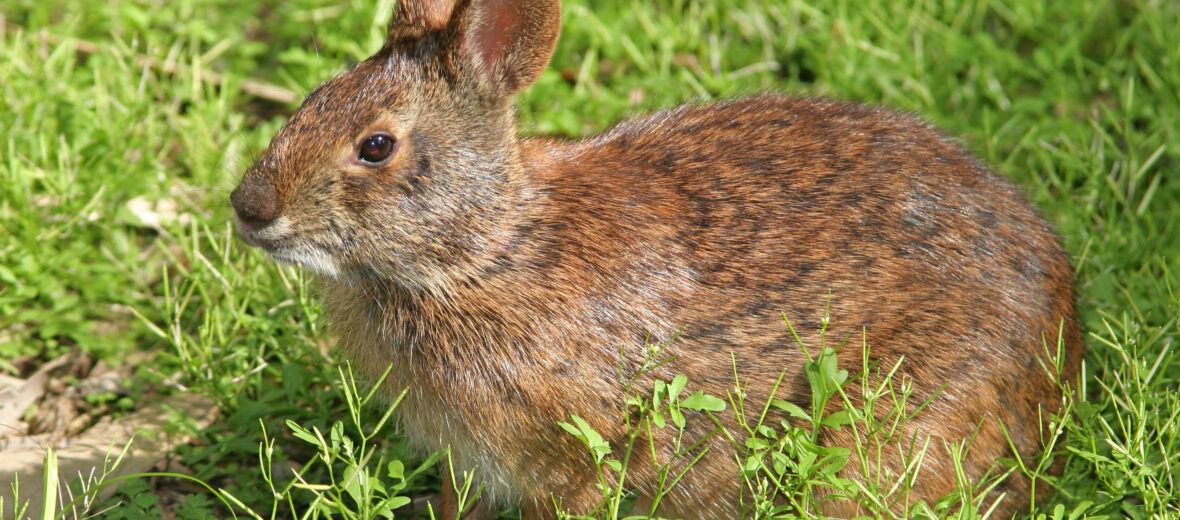
The marsh rabbit can be found in southeastern United States; from Virginia, Alabama, North Carolina, South Carolina, Georgia, to Florida. They prefer freshwater and brackish marshes, mangrove swamps, and sandy islands; as long as they have plenty of access to water. These bunnies can often be found hiding in thickets of black-gum, sweet-gum, magnolia, briers, and cattails. Even though they face the threats of habitat destruction, hunting, trapping, vehicle strike (being hit by vehicles), invasive species, and disease, these critters are still listed as Least Concern by the IUCN.
First the Stats…
Scientific name: Sylvilagus palustris
Weight: Up to 6 lbs.
Length: Up to 16 inches
Lifespan: Up to 4 years
Now on to the Facts!
1.) Marsh rabbits are solitary creatures that only come together to breed or when food is plentiful.
2.) They are nocturnal (active at night).
3.) These hoppers make runway trails in thick vegetation along the marsh edges. Their trails are often marked with dung (poop) pellets.
4.) The marsh rabbit tends to be even more aquatic oriented than the swamp rabbit, since they aren’t found in or around forests.
5.) As a defense, these critters will often submerge themselves in muddy water with only their eyes, nose, and flattened ears exposed.
But wait, there’s more on the marsh rabbit!
6.) Their first response to being found is to bolt for the water. On land, they hop in a turning and doubling fashion. Due to their short legs, they are easily picked off by predators while on land. Hence the need for water escapes.
7.) A group of rabbits is called a rest or colony.
Did you know…?
Unlike other rabbits, marsh rabbits are able to walk on all fours, although they can also hop, if needed.
8.) They feed on the bulbs and leaves of cattails, brushes, grasses, marsh pennywort, water hyacinth, centella, greenbrier vine, amaryllis, and wild potato.
9.) Great horned owls, marsh hawks, bald eagles, eastern diamondback rattlesnakes, and cottonmouths all prey on marsh rabbits.
10.) The marsh rabbit is polygynandrous (promiscuous – males and females have multiple partners).
But wait, there’s more on the marsh rabbit!
11.) Just as rabbits are known for, their breeding season is year round.
12.) Females undergo up to a 37 day gestation (pregnancy) that yields up to 4 kittens.
Did you know…?
Marsh rabbits re-ingest their food. This is known as coprophagy. They also consume soft fecal pellets, known as cecal pellets, that are later re-digested which gives them further nutrients. These cecal pellets are different than their normal poop pellets.
13.) Like other rodentia, the babies are born altricial (blind and helpless).
Did you know…?
There is a deadly and highly contagious disease afflicting rabbit populations in North America, called the rabbit hemorrhagic disease virus (RHDV2). This affects both wild and captive rabbits. Most times, the only signs of the disease are sudden death and blood stained noses caused by internal bleeding. So far, there are 11 states affected, including Arizona, California, Colorado, Texas, Montana, New Mexico, Utah, and Wyoming; according to the USDA.
14.) The young are weened at just 15 days and they reach sexual maturity before their first year.
15.) They have a smaller tail, smaller legs, and smaller ears than swamp rabbits.
Now a Short Marsh Rabbit Video!
Be sure to share & comment below! Also, check out the Critter Science YouTube channel. Videos added frequently!
Want to suggest a critter for me to write about? Let me know here.



